Weathering the climate: Michigan agriculture braces for Mother Nature with help of MSU research
Agricultural producers throughout the state have recently had to deal with some of Mother Nature's brutal wrath. Thanks to MSU research, they're helping to be better prepared and equipped to address those challenges.

"Despite improvements in technology, weather and climate remain among the most important uncontrollable factors in agricultural production systems.”
State climatologist Jeff Andresen first heard this statement or something pretty close to it from one of his graduate school professors almost 30 years ago. He has used it ever since and intends to keep it in his repertoire for decades to come.
Weather and climate affect all facets of agriculture, and they can do so in dramatically different fashion — what’s good for one commodity can be detrimental to another. In Michigan, which boasts the second most diverse agricultural production in the United States, this conundrum translates into lots of opportunities for research. On the flip side, even experienced meteorologists such as Andresen acknowledge that there are certain limitations in the science.
“On one hand, we all know that meteorologists are the brunt of jokes, and some of them are probably justified,” he said. “However, it’s also important to note that the science is getting better. For example, weather forecasts are significantly more accurate than they were in past decades. There is also more known about how weather and climate influence agriculture. That’s where Michigan State University (MSU) comes into play. We have a role to provide new science and other information that help reduce weather-related risk for farmers.”
Andresen, a MSU geography professor and Extension specialist, has been helping Michigan farmers prepare for Mother Nature’s wrath since coming to work at MSU in 1991. At that time, he was the only MSU faculty member providing meteorology expertise to agricultural producers. Faced with a steep learning curve, Andresen recalls the advice of a colleague that provided the Illinois native more familiar with corn and soybean production one of his most valuable lessons.
“Right off the bat, people from the Michigan fruit and vegetable industries had lots of questions,” he said. “Initially, I wasn’t prepared — the needs were huge. My Extension colleagues were wonderful in providing helpful advice. One suggested that if I really wanted to learn about what fruit growers routinely face, I should plant my own fruit trees, which I did. I quickly started to appreciate how demanding it is to produce these types of crops, given what Mother Nature throws at us.”
Over the years, Andresen has grown apples, cherries, pears, peaches and brambles. He’s given blueberries and grapes a try but without much success. The firsthand experience has provided tremendous insight into the challenges confronting Michigan agricultural producers, particularly the fruit industry. And one doesn’t have to go very far back on the calendar to find proof of that.
The nightmare of spring 2012
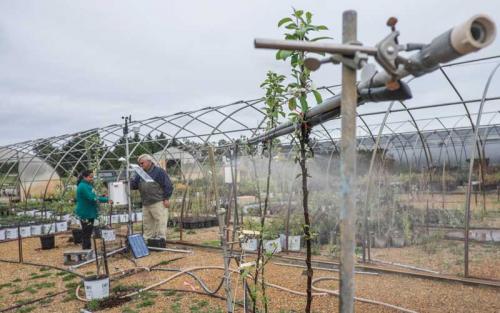 The spring of 2012 ranks among the most destructive weather periods in Michigan fruit production history, with crop losses valued at more than $500 million. Unprecedented warm temperatures in March caused overwintering perennials to come out of dormancy more than a month early. The unseasonably early warm-up was followed by damaging freezes in April and May that almost completely devastated Michigan fruit crops. Peach production suffered a 95 percent loss; tart cherry, a 90 percent crop loss; apple production, an 88 percent loss; and grapes, an 85 percent loss.
The spring of 2012 ranks among the most destructive weather periods in Michigan fruit production history, with crop losses valued at more than $500 million. Unprecedented warm temperatures in March caused overwintering perennials to come out of dormancy more than a month early. The unseasonably early warm-up was followed by damaging freezes in April and May that almost completely devastated Michigan fruit crops. Peach production suffered a 95 percent loss; tart cherry, a 90 percent crop loss; apple production, an 88 percent loss; and grapes, an 85 percent loss.
It was a year that fruit growers wanted to quickly forget and to never relive. It was also the most difficult time of Andresen’s career.
“We have about 120 to 140 years of Michigan climate data, depending on location, that is considered reliable. Conditions during March 2012 just blew everything away,” he said. “There was a departure from normal temperatures of 13.8 degrees — it’s almost unheard of to have a double-digit departure from normal. There were places in the U.P. that went from having over 40 inches of snow to bare ground in one week. These were conditions that had not really been documented or written about before.”
With cherry trees in bloom during March, growers knew they were in for trouble. It was only a matter of time before freezing temperatures would return and destroy the buds. And they did with a vengeance, with some locations experiencing 15 to 20 freezes following the unprecedented heat wave, Andresen said.
While the Michigan fruit industry was reeling from the devastating losses, MSU AgBioResearch horticulturist James Flore had an idea. He knew of a research project conducted in Utah during the 1970s that utilized the application of water to delay tree fruit bloom. Although the research had shown promise, Flore said the technique was not practical at the time because it used large amounts of water, increased incidence of plant disease and decreased fruit set.
Flore, who joined forces with Andresen on the new project, thought that incorporating modern-day technological advancements might give more promising and practical results than the initial study. Because plant development is driven by heat accumulation within the bud from exposure to warming temperatures, the researchers knew they would have to cool down the buds. They decided to use water but delivered in a more controlled method than used in the Utah project.
Flore and his team are utilizing three new technologies in the study:
- A solid-state canopy delivery system (SSCD), which finely mists the trees and gives uniform coverage.
- Highly precise orchard weather monitoring and control systems.
- Mist applications based on temperature, humidity and wind, which maximizes the evaporative cooling effect of water while minimizing the amount of water used.
In almost two seasons (2013 and 2014) of testing on Gala, Honeycrisp and Red Delicious apples in four orchards across the Lower Peninsula, Flore and his team have been successful in delaying bloom by five to 11 days on average without any apparent disease or fruit-set issues. They have also been able to substantially decrease water use compared with the 1970s study. Although more work is necessary, Flore remains optimistic.
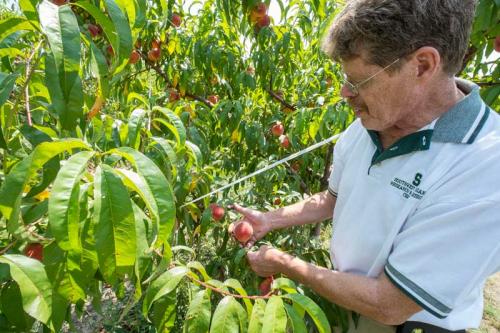 “Growers using the SSCD to apply pesticides coupled with a weather monitoring control unit have the potential to avoid flower bud frost damage by delaying bloom by more than a week,” Flore said. “This is important, given that climate change has resulted in earlier blooming of fruit crops, which has increased vulnerability to spring frost — as directly evidenced in spring 2012.”
“Growers using the SSCD to apply pesticides coupled with a weather monitoring control unit have the potential to avoid flower bud frost damage by delaying bloom by more than a week,” Flore said. “This is important, given that climate change has resulted in earlier blooming of fruit crops, which has increased vulnerability to spring frost — as directly evidenced in spring 2012.”
Andresen said it is advantageous for growers to have procedures that help delay bloom because the spring warm-up is gradually occurring earlier with time, and Great Lakes fruit is particularly vulnerable just following the warm-up. Unfortunately, even though the length of the growing season has increased on average by about 1.5 weeks in the past 30 years, the number and severity of spring freeze events are not decreasing as quickly.
“Overall, this translates to more risk to the grower,” Andresen said. “As a result, for many fruit crops we see more growers installing some form of frost protection technology, such as wind machines.
The fans can generate several degrees of warming, but sometimes that’s not enough to prevent cold injury.”
To add insult to injury, the damaging spring in 2012 was followed by the worst drought in Michigan since 1988. Many crops continued to suffer through the summer, but sugar beets ended with a banner crop.
“This one year weatherwise was a train wreck, with the March heat wave followed by a series of freezes and then drought. Almost all of the crops were down in production except sugar beets,” he said. “That was the year for sugar beets, and it just illustrates how some weather patterns can be beneficial to one crop and yet be bad for another.”
The bitter cold winter 2013-14
It wasn’t long after spring 2012 when Michigan was hit with more extreme weather. Enter the winter of 2013-14, when a series of bitterly cold air masses rolled down from the Arctic, through Canada and into Michigan. The period between November 2013 and February 2014 was the coldest in Michigan since 1911 and among the five coldest periods on record in the state.
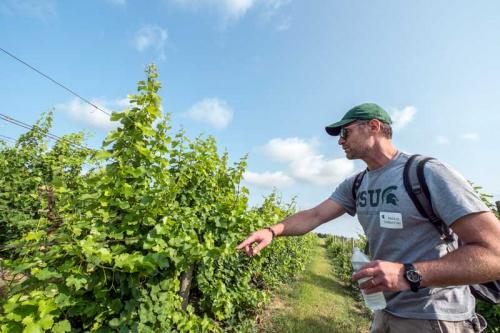 The severe conditions of 2013-14 followed a series of mostly milder than normal winters.
The severe conditions of 2013-14 followed a series of mostly milder than normal winters.
“Unquestionably, the long-term trend in recent decades has been toward milder winters,” Andresen said. “But then you get a winter like last year, and it defies the statistics. It’s literally off the scale, and it just doesn’t make any sense at all. It’s a reminder of the importance of climatevariability and extremes, which, though few in number, typically account for a majority of weather-related impacts."
The duration and amount of ice cover on the Great Lakes in winter 2013-14 were the greatest in more than 40-some years, and it was the most extensive and longest accumulation of snow in many portions of Michigan since the late 1970s, Andresen said. It was a trying winter that took a severe toll on wine grapes, peaches and blueberries and seemed to catch everyone by surprise. One source, however, managed to see it coming.
“The Farmer’s Almanac was the only source that I’m aware of that forecasted a brutal winter,” Andresen said. “No one, not even the National Weather Service, nor any private organization that I know of saw it coming, so we have to give credit where credit is due.”
Weather forecasting in Michigan is particularly difficult because of the geographic location of the state, Andresen noted.
"Where we are geographically - in the midlatitudes - variability is the hallmark of our climate," he said. "It has to do with the configuration of the jet stream, the largest and most prominent control in our day-to-day weather. In my professional career, I had never seen anything like the winter of 2013-14 before. It’s extremely unusual for the jet stream to persist in such a pattern over the same area – resulting in the passage of one Arctic-origin air mass after another — for so long.”
For residents of the Midwest and the Northeast, one could probably consider this part of the misfortune of being in the wrong place at the wrong time. In contrast to the frigid conditions in central and eastern sections of North America, most other regions of the Northern Hemisphere — including areas as close as the western United States and Alaska — recorded an abnormally mild winter.
Mark Longstroth, a Michigan State University Extension small fruit educator who often writes about weather impacts on agriculture, said that last winter will long be remembered for its extreme cold and high snow accumulation. He explained that most perennial crops grown in Michigan have the ability to withstand subfreezing temperatures. but this past winter tested even the strongest cold-hardy varieties.
“A general rule of thumb is that most of our fruit crops can handle 0 degrees F during the winter as their minimal cold hardiness,” Longstroth said. “With colder temperatures, below freezing, the cold hardiness of the plant cells increases, and our cold-tender plants — such as peaches, blueberries and wine grapes - can withstand temperatures down to -10 degrees F before we see injury to the fruit buds."
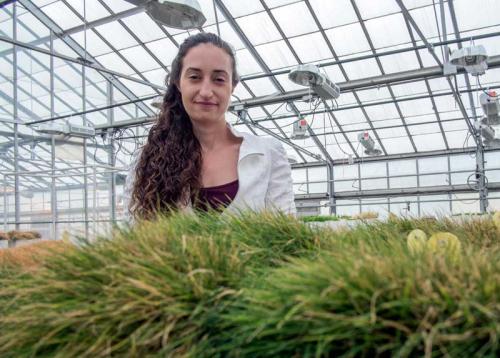 MSU Extension specialist William Shane said the impact of the harsh winter on peaches varied throughout the state; a rough overall estimate is about a 60 percent loss. He said temperatures below -12 degrees F in January and February are tough on peaches, and temperatures below -15 degrees F drastically reduce peach fruit bud survival. Shane said, however, that he suspects that a rapid temperature drop in early December 2013 followed by a warm spell was the culprit in most of the peach damage.
MSU Extension specialist William Shane said the impact of the harsh winter on peaches varied throughout the state; a rough overall estimate is about a 60 percent loss. He said temperatures below -12 degrees F in January and February are tough on peaches, and temperatures below -15 degrees F drastically reduce peach fruit bud survival. Shane said, however, that he suspects that a rapid temperature drop in early December 2013 followed by a warm spell was the culprit in most of the peach damage.
“I blame the peach tree declines we saw this growing season on an approximate 30-degree temperature drop within a few days from late November to early December 2013 in some Michigan areas,” he said. “A lot of older peach and apple trees were pulled out this spring and summer.”
The European wine grapes used to make Merlot, Cabernet Franc and other red wines were also hit hard by the heavy snowfall and subzero temperatures. MSU AgBioResearch horticulturist Paolo Sabbatini, also an Extension specialist, urged growers to delay pruning as long as possible during the dormant period to cope with the extensive winter injury.
“The 2013-14 winter was a forceful reminder that cultivar choice and site selection are still the most important tools we have against low winter temperatures, which are typical of our viticulture regions in the Midwest and eastern United States,” he said.
The turfgrass industry also reported large amounts of winterkill damage on putting greens and other turf areas in the mid-central to southeastern parts of the state due to the excessive cold and long duration of ice cover. In direct response, MSU AgBioResearch scientist Emily Merewitz worked with the industry to obtain a new low-temperature growth chamber. In the chamber, turf researchers evaluate common golf course putting green turfgrass species to see how they may differentially survive ice cover and encasement. They will determine physiological mechanisms of winterkill tolerance, as well as possible effects of commonly used turf chemicals such as plant growth regulators on turf survival of winterkill.
“The growth chamber imitates harsh winter conditions in a controlled setting so that researchers can investigate topics such as ice damage, cold acclimation and de-acclimation, and other issues related to winterkill damage year round,” Merewitz explained.
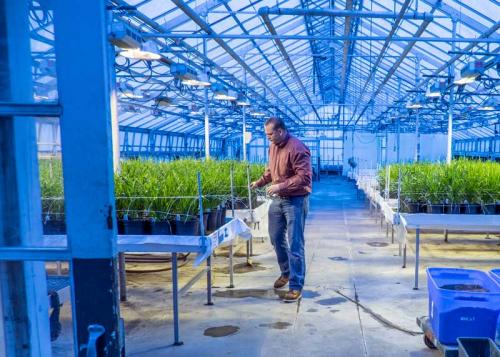 The winter damage to wheat varied depending on location, with some counties having to replant wheat acres with corn or soybean instead. Despite the tough winter, MSU AgBioResearch wheat breeder Eric Olson said the 2014 crop fared better than initially anticipated, with yields just slightly below average. Olson, who is conducting trials through the MSU Wheat Breeding Program, said he is seeing a correlation between grain yield and winter hardiness.
The winter damage to wheat varied depending on location, with some counties having to replant wheat acres with corn or soybean instead. Despite the tough winter, MSU AgBioResearch wheat breeder Eric Olson said the 2014 crop fared better than initially anticipated, with yields just slightly below average. Olson, who is conducting trials through the MSU Wheat Breeding Program, said he is seeing a correlation between grain yield and winter hardiness.
“Lines with exceptional winter hardiness tended to yield much higher,” Olson said. “A positive outcome of the extreme winter conditions is that lines advanced through the wheat breeding program this year all have exceptional winter hardiness."
One other silver lining amidst all of the destruction is that the winter’s massive amounts of snow helped to raise lake levels and replenish soil moisture.
A changing climate
The extreme winter of 2013-14 aside, Andresen said that chronological data shows that Michigan’s climate is becoming warmer and also wetter. The mean annual temperature has risen from 44 degrees F to 46 degrees F since 1980, and annual precipitation has increased about 4.5 inches on average since the late 1930s.
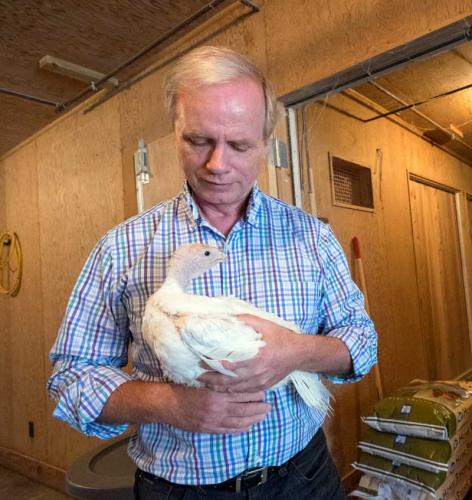 “In Michigan, we have a relatively short growing season compared with other agricultural areas,” he said. “But on paper and at least from our research, these climatic changes have allowed us to become more productive. We have agricultural areas in the state that did not exist two or three decades ago. Some of that is due to improving technology, but the climate has played a role as well.”
“In Michigan, we have a relatively short growing season compared with other agricultural areas,” he said. “But on paper and at least from our research, these climatic changes have allowed us to become more productive. We have agricultural areas in the state that did not exist two or three decades ago. Some of that is due to improving technology, but the climate has played a role as well.”
Andresen added that drought is occurring less frequently, from about once every 10 to 15 years to once every 20 years.
Providing growers with ways to mitigate the impacts of climate change on agriculture is a research priority for MSU AgBioResearch.
“Weather patterns are changing — we need to respond to the impact on agriculture,” said Douglas Buhler, director of MSU AgBioResearch and associate dean of research for the College of Agriculture and Natural Resources. " We can argue about what’s causing it, but we need to deal with it and learn how to best respond. Our perennial crops are particularly vulnerable to relatively minor changes in weather, so Michigan has a lot at stake in understanding this.”
Climate change is also having potential effects on animal agriculture. Earlier this year, MSU AgBioResearch scientist Gale Strasburg was awarded a nearly $1 million grant from the U.S. Department of Agriculture to study the impact of temperature extremes on turkey development. The project was one of several funded by the USDA to assess the impact of climate change on livestock and poultry.
Strasburg, a professor in the Department of Food Science and Human Nutrition, will assess how turkeys respond to heat and cold stress after being moved from the controlled atmosphere of a hatchery to a farm, and how that may affect the quality of turkey meat, especially the breast, which is the most valuable portion. Having studied genetic and cellular issues in turkeys for over a decade, Strasburg hypothesizes that exposing incubating eggs to a mild temperature increase for two to three hours per day toward the end of their embryonic development will enhance the ability to adapt to thermal stress
“The turkey industry is really interested in a consistent product, and being able to reduce the effects of extreme temperatures will help maintain or improve that consistency,” he said. “The more efficiently you can produce high quality protein, the more advantageous your position will become. This adaptation strategy, we think, will help our producers do this easily as a component of management practices and without the need to wait for the benefits of breeding more stress-tolerant birds.”
One MSU research endeavor has been gathering valuable long-term weather and climate data for nearly two decades. Enviro-weather is a network of 74 automated weather stations throughout Michigan and six in Door County, Wisconsin (a collaboration with fruit growers there). Started in the late 1990s with funding from Project GREEEN (Generating Research and Extension to meet Economic and Environmental Needs), Enviro-weather captures routine information such as temperature, humidity and precipitation, along with detailed data on soil temperature, solar radiation and leaf wetness. Each station consists essentially of a computer chip, a battery and a solar panel and operates on its own to record measurements and observations of these variables.
Researchers at MSU have developed simple ways for growers to utilize the Enviro-weather data in pest, disease and weed management, as well as irrigation assessments. Andresen said 40 types of products and models are now available through the system, but the majority of requests are for the raw data.
“People most want to see the raw data, and that continues to amaze me. I would have never guessed that,” he said. “Perhaps that means people want to carry out their own types of applications, their own variation. I don’t know.”
Still, it is a reminder of the increasing need for detailed weather information to support agricultural management activities. The number of visits to the site now averages more than 7,000 per day, an increase of over 1,400 percent since 2006, the first year of operation.
Nearing 20 years of data collection at some of its network sites, Enviro-weather will increasingly offer some historical perspective, also, equipping researchers with the ability to say how common or how unusual a certain type of weather event is.
In the meantime, researchers agree that climate conditions in Michigan are generally improving for agricultural production. Extreme weather events such as spring 2012 and winter 2013- 14 are typically challenging and will require research attention. Surrounded now by fellow researchers and Extension specialists looking at various aspects of weather and climate and their impact on agriculture, Andresen is optimistic.
“Compared to when I first started here, MSU now has more faculty and staff members involved in atmospheric science- related research and programs,” he said. “I would definitely say that we’re more effective, and with the larger teams, we are able to address more topics than we have in the past. The science is definitely moving in the right direction, and we’re working hard to find solutions for the agriculture industry.”
New book showcases how Midwest climate might change
Michigan State University (MSU) geography professor Julie Winkler is the lead editor of a new technical book titled “Climate Change in the Midwest: A synthesis report for the National Climate Assessment.”
The report, published by Island Press, also features contributions by several other MSU faculty including Jeff Andresen from the department of geography; Janice Beecher from the Institute of Public Utilities; and Sarah Nicholls from the departments of geography and community sustainability.
Prepared as a more in-depth scholarly exploration of the National Climate Assessment, the book addresses the potential impacts of climate change on natural systems, human health and several important economic sectors in the Midwest.
“The diverse landscape of the U.S. Midwest and the natural processes, livelihoods and infrastructure associated with them, are vulnerable to climate change,” said Winkler. “The challenge will be to design and implement creative and effective adaptation strategies to reduce the region’s vulnerability to climate change, while capitalizing on potential co-benefi of mitigation policies.”
Coordinated by the Great Lakes Integrated Sciences and Assessments (GLISA) Center and the USDA Agricultural Research Service, the technical report adds more detail to the conclusions of the National Climate Assessment, which listed the following key message for the Midwest:
“Extreme rainfall events and flooding have increased during the last century, and these trends are expected to continue, causing erosion, declining water quality, and negative impacts on transportation, agriculture, human health and infrastructure.”
The peer-reviewed publication is intended for educational research purposes mainly for undergraduate and/ or graduate teaching support, as well as to help industry stakeholders make informed decisions on a variety of topics from energy regulation to managing water systems in the Midwest, said Winkler.
Some key findings of the report include:
- Annual mean temperature in the Midwest has warmed since approximately 1900, with annual precipitation generally increasing from the 1930s to present. Regardless of season, intensification of high magnitude precipitation events is anticipated.
- Great Lakes surface water temperatures have increased over the past few decades. Continued warming will impact the timing and extent of thermal stratification, winter ice cover and the availability of dissolved oxygen.
- Adjustments to temperature change would necessitate rapid and perhaps unrealistic movement of plant and animal species if they are to maintain pace with expected shifts in habitat ranges.
- Forest ecosystems may be less likely to provide a consistent supply of some forest products, especially if the dominant species in those ecosystems are at the southern edges of their ranges.
- Changes in the variability, timing and amount of growing season precipitation will have a substantial impact on future crop yields and the number of workable field days.
- Warmer springs and falls will increase the attractiveness of such activities as camping, golfing and boating while winter sports may be adversely impacted.
- The region has a number of climate-sensitive diseases and health conditions, and, on balance, adverse health ramifications are anticipated to outweigh beneficial health outcomes.
Winkler became involved with the project primarily as a core team member of GLISA, one of 11 National Oceanic and Atmospheric Administration-funded centers that aim to build capacity to manage risks from climate change and the variability in the Great Lakes region.
“The Midwest papers are excellent and give a solid sense of the climate state for our region,” said Thomas Dietz, MSU assistant vice president for environmental research. “This collaborative effort was led by GLISA, Michigan State University and the University of Michigan — all prominent climate entities in the region. It is a very useful collection of papers that should serve many different sectors very well throughout the century.”
This is Winkler’s first experience editing a book. She grew up on a farm in North Dakota where she became fascinated with weather at a young age. She came to MSU in 1987 after receiving her Ph.D. in geography with a specialization in climatology.



 Print
Print Email
Email




